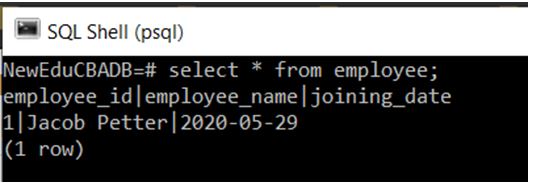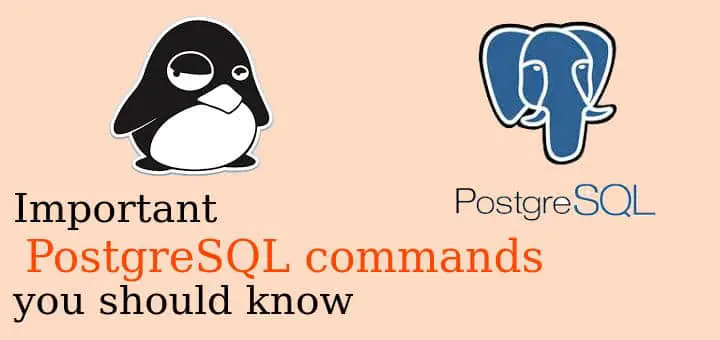

- #Json with postgresql commands how to
- #Json with postgresql commands install
- #Json with postgresql commands update
- #Json with postgresql commands password
UPDATE SET raw = %s """, ( feed_url, body, body ) ) Speaking of conflicts, let’s also update the Python script so that it does an update on a conflict in the jsonfeed_raw table: cur. Note the slightly different ON CONFLICT syntax, where we have to specify a column name unlike in the SQLite version. This is a little more verbose, but does the same thing. RETURN NULL - Ignored because this is an AFTER triggerĪFTER INSERT OR UPDATE OR DELETE ON jsonfeed_rawįOR EACH ROW EXECUTE FUNCTION jsonfeed_update ( ) That’s going to look something like this: DROP TRIGGER IF EXISTS jsonfeed_raw_ins ON jsonfeed_raw ĬREATE FUNCTION jsonfeed_update ( ) RETURNS trigger AS $jsonfeed_update$ The easiest choice in this case is to use PL/pgSQL, which is a PostgreSQL-specific superset of SQL.

Instead we have to write a function in another language and call that. It’s not currently possible to write triggers in plain SQL 2.


Triggers are a little more complex in PostgreSQL. , raw - > 'home_page_url ' AS home_page_url Populating the second table looks fairly similar, although note the different operators inside the SELECT: INSERT INTO jsonfeed_metadata , updated_at TEXT NOT NULL DEFAULT NOW ( ) I only had to make one change to the syntax here, to the default value on the updated_at column: CREATE TABLE IF NOT EXISTS jsonfeed_metadata Let’s go on and create the metadata table and insert the data into it. Select jsonb_path_query(raw, '$.items.title') from jsonfeed_raw Request ( feed_url, headers = ' as post_title from jsonfeed_raw
#Json with postgresql commands password
connect ( host = ' localhost ', dbname = ' mydb ', user = ' mydb ', password = ' mydb ', ) def get_feed ( feed_url ) : req = urllib. #! nix-shell -p python39 python39Packages.psycopg2 -i python There are a couple of Python libraries for communicating with PostgreSQL, but the one I’m most familar with is the dubiously-named psycopg2. I don't normally write SQL like this, but I'll go with the flow. , scrape_date TIMESTAMP NOT NULL DEFAULT NOW ( ) The key differences are the column types I’m using ( timestamp and jsonb), and the slightly different syntax required for the default timestamp. Let’s create a table, and throw some data into it. For this example I’m going to assume the database is local, and the database, username and password are all mydb.
#Json with postgresql commands install
Because I’m a Nix fan I used nix-shell to install PostgreSQL, as described in a previous post. There are plenty of tutorials for getting this up and running already elsewhere. I’ve only ever used jsonb, and I’ll continue to do that here.īecause PostgreSQL is a relational database server, there is some work around setting up a new database and its permissions that I’m going to skip past. The json type stores an exact copy of the input text, while jsonb transforms it into a binary form that is faster for many operations as well as being indexable. However, PostgreSQL has a separate JSON datatype. SQLite uses text data types to store JSON in, and has operators which can work on that. There are some neat features in 14, like array subscripting for JSON column types and things like that, which are worth reading up on. My site doesn’t have a JSONFeed endpoint (yet, perhaps Zola will acquire one, one day), so I’m going to borrow Xe’s feed and Python script as the basis for what I do here. It turns out that similar capabilities exist in both databases, so I’m going to translate Xe’s post more or less directly into PostgreSQL equivalents. I’ve been meaning to write up what I learned for some time now before I banished forgot it entirely, so Xe’s post was a good prompt. I learned a bit about PostgreSQL’s JSON functions in the process. On the other hand, in 2020 I spent a lot of time with a team demolishing an old enterprise system at work, with a fairly convoluted database structure.
#Json with postgresql commands how to
Xe’s post about JSON in SQLite talks a lot about how to use SQLite to handle JSON data and load it into other tables without having to have your application do it, which is great. I’ve been using SQLite a bit in some of my own projects recently, and I think it’s a great solution for small self-hosted applications, avoiding the need to run a full-blown RDBMS where it’s not really warranted.


 0 kommentar(er)
0 kommentar(er)
